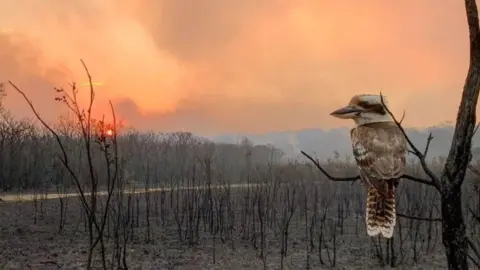Australia bushfires: Fresh warnings in Queensland and New South Wales
 ADAM STEVENSON/Reuters
ADAM STEVENSON/ReutersAustralian authorities have warned that massive bushfires raging in two states will continue to pose a threat, despite "catastrophic" conditions easing.
About 150 fires are still burning in New South Wales (NSW) and Queensland, feeding off tinder-dry conditions.
Fifty houses were destroyed or damaged in NSW on Tuesday but no lives were lost, officials said. At one point, fires broke out in suburbs of Sydney.
On Wednesday, blazes caused fresh emergencies in Queensland.
"The conditions are of concern to us," Queensland Premier Annastacia Palaszczuk told reporters.
The threat in NSW has been downgraded from catastrophic - the highest level - but officials urged residents to remain vigilant.
"We've got the worst of the summer - the worst of the season - still ahead of us as we head into summer," said NSW Rural Fire Services Commissioner Shane Fitzsimmons.
Australia's government has often avoided questions on whether climate change could have contributed to the fires, in a response that has drawn criticism.
What's happening in Queensland?
More than 70 bushfires are burning in the state amid forecasts of high temperatures, volatile winds and dry lightning.
Residents in Noosa North Shore, on the popular Sunshine Coast, were among those to be issued emergency warnings on Wednesday.
A water-bombing helicopter crashed while fighting a fire at Pechey, west of Brisbane, but the pilot survived with only minor injuries.
Officials warned that no significant rain was expected, putting continuing strain on firefighters.
What about NSW?
Mr Fitzsimmons said it was a relief that no-one had died on Tuesday given "the enormity of these fire grounds". About 1.1 million hectares have been scorched in NSW since September.
The worst fires dot NSW from its northern border to a national park north of Sydney. Though perimeters constantly shift, most are in populated coastal zones or further inland.


Since Friday, three people have died and up to 200 homes have been razed.
Flame retardant had to be dropped in Sydney's northern suburbs as some bushfires approached within 15km (nine miles) of the city centre.
A firefighting plane dropped pink fire retardant in the area between Macquarie University and the Sydney Adventist Hospital in the South Turramurra suburb.
One resident who evacuated, Diksha Anand, told the BBC she had feared losing her house.
Actor Russell Crowe tweeted that his property had been damaged, but he was overseas and his family was safe.
Allow X content?

Mr Fitzsimmons said: "We've really got a long way to go. You can guarantee we're not going to be able to get around all of these fires before the next wave of bad weather.
"Unfortunately there's no meaningful reprieve. There's no rainfall in this change and we're going to continue to have warm dry conditions dominating in the days and weeks ahead."
Police are investigating reports that several fires may have been started deliberately.

Mr Fitzsimmons said 3,000 firefighters were on the front lines, boosted by crews from other states and New Zealand, as well as the Australian Defence Force.
Is this linked to climate change?
Scientists and experts warn that Australia's fire season has grown longer and more intense due to climate change.
Officials have confirmed that 2018 and 2017 were Australia's third and fourth-hottest years on record respectively, and last year the nation experienced its warmest summer on record.
The Bureau of Meteorology's State of the Climate 2018 report said climate change had led to an increase in extreme heat events and raised the severity of other natural disasters, such as drought.
Even if global temperatures are contained to a 2C rise above pre-industrial levels - a limit set out in the landmark Paris accord, agreed by 188 nations in 2015 - scientists believe the country is facing a dangerous new normal.
The fires have led to disagreements between politicians over whether climate change is to blame.
Former deputy prime minister Barnaby Joyce suggested that climate activists were partly responsible for the fires by calling for the reduction of so-called back burns, fires purposefully started to clear dry undergrowth.
Independent lawmaker Zali Steggall called Mr Joyce's remarks "unbecoming of our parliament".
"What we want is a consensus moving forward on how to come up with a plan that adapts Australia to a warming climate," she told the Australian Broadcasting Corporation.
Prime Minister Scott Morrison has declined to comment on climate change while the fires rage.

Have you been affected by the bushfires? Share your experiences by emailing [email protected].
Please include a contact number if you are willing to speak to a BBC journalist. You can also contact us in the following ways:
- WhatsApp: +44 7756 165803
- Tweet: @BBC_HaveYourSay
- Text an SMS or MMS to 61124 or +44 7624 800 100
- Please read our terms of use and privacy policy
